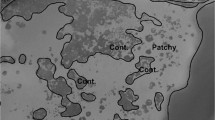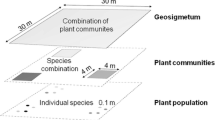Abstract
Management of coral reef resources is a challenging task, in many cases, because of the scarcity or inexistence of accurate sources of information and maps. Remote sensing is a not intrusive, but powerful tool, which has been successfully used for the assessment and mapping of natural resources in coral reef areas. In this study we utilized GIS to combine Landsat TM imagery, aerial photography, aerial video and a digital bathymetric model, to assess and to map submerged habitats for Alacranes reef, Yucatán, México. Our main goal was testing the potential of aerial video as the source of data to produce training areas for the supervised classification of Landsat TM imagery. Submerged habitats were ecologically characterized by using a hierarchical classification of field data. Habitats were identified on an overlaid image, consisting of the three types of remote sensing products and the bathymetric model. Pixels representing those habitats were selected as training areas by using GIS tools. Training areas were used to classify the Landsat TM bands 1, 2 and 3 and the bathymetric model by using a maximum likelihood algorithm. The resulting thematic map was compared against field data classification to improve habitats definition. Contextual editing and reclassification were used to obtain the final thematic map with an overall accuracy of 77%. Analysis of aerial video by a specialist in coral reef ecology was found to be a suitable source of information to produce training areas for the supervised classification of Landsat TM imagery in coral reefs at a coarse scale.
Similar content being viewed by others
References
Ahmad, W. and Neil, D. T.: 1994, ‘An evaluation of Landsat TM digital data for discriminating coral reef zonation: Heron Reef (GBR)’, Int. J. Remote Sensing 15, 2583–2597.
Ardisson, H. P., Duncan, J., Aguirre, L. and Canela, J.: 1996, ‘Programa de manejo del Parque Marino Nacional Arrecife Alacranes, Yucatán, México’, CINVESTAV-IPN. Mérida, México.
Bainbridge, S. and Reichelt, R.: 1988, ‘An Assessment of Ground Truth Methods for Coral Reef Remote Sensing Data’, in: Proceedings of 6th International Coral Reef Symposium, pp. 439–444.
Bello, P. J.: 1998, ‘Sistema de clasificación para los tipos de fondo del arrecife Alacranes compatible con una imagen Landsat TM’, CINVESTAV-IPN, Mérida, México.
Bonet, F.: 1967, ‘Biogeología subsuperficial del Arrecife Alacranes, Yucatán’, Instituto de Geología, UNAM. México.
Chuvieco, E.: 1990, ‘Fundamentos de teledetección espacial’, RIALP, Madrid.
Crosby, M. P., Brighouse, G. and Pichon, M.: 2002, ‘Priorities and strategies for addressing natural and anthropogenic threats to coral reefs in Pacific Island Nations’, Ocean Coastal Manag. 45, 121–137.
De la Cruz, G., Martínez, E. and Muñoz, R.: 1993, ‘Propuesta de zonificación del Arrecife Alacranes, Yucatán’, CINVESTAV, Mérida.
Digby, P. and Kempton, R.: 1987, Multivariate Analysis of Communities, Chapman and Hall, London-NewYork.
Done, T.: 1981, ‘Rapid, Large Area, Reef Resource Surveys Using a Manta Board’, in: Proceedings of 4th International Coral Reef Symposium, pp. 299–308.
Erftemeijer, P.: 2002, ‘A new technique for rapid assessment of mangrove degradation: A case study of shrimp farm encroachment in Thailand’, Trees 16, 204–208.
Fernandes, L., Ridgley, M. A. and van’t Hof, T.: 1999, ‘Multiple criteria analysis integrates economic, ecological and social objectives for coral reef managers’, Coral Reefs. 18, 393–402.
Gónzalez, G., C.: 2001, ‘Las comunidades de peces del Arrecife Alacranes, Yucatán, México: Variaciones espacio-temporales’, CINVESTAV-IPN, Mérida, México.
Green, E. P., Mumby, P. J., Edwards, A. J. and Clark, C. D.: 2000, ‘Remote sensing handbook for tropical coastal management’, Coastal management sourcebooks 3, UNESCO, Paris.
Human, P.: 1994, Reef Coral Identification, New World Publications, INC, Florida.
Kenchington, R.: 1978, ‘Visual Surveys of Large Areas of Coral Reefs’, in: D. Stoddart and R. Johannes (eds.), Coral Reefs Research Methods, UNESCO, Paris, pp. 149–161.
Legendre, L. and Legendre, P.: 1983, Numerical Ecology, Elsevier Scientific Publishing Co, New York.
Lewis, J. B.: 2002, ‘Evidence from aerial photography of structural loss of coral reefs at Barbados, West Indies’, Coral Reefs 21, 49–56.
Liceaga-Correa, M. A. and Euan-Avila, J. I.: 2002, ‘Assessment of coral reef bathymetric mapping using visible Landsat Thematic Mapper data’, Int. J. Remote Sensing 23, 3–14.
Liceaga-Correa, M. A. and Hernández-Núñez, H.: 2000, ‘Localización y dimensiones del Arrecife Alacranes’, Jaina 11, 8–10.
Magellan Systems Corporation: 1995, ‘Magellan NAV DLX-10 User Guide’, San Dimas, California.
Meaden, G. and Do Chi, T.: 1996, ‘Geographical Information Systems: Applications to Marine Fisheries’, FAO, Rome.
Microimages: 2001, ‘Reference manual for TNT Products V6.8’, Lincoln, NE. U.S.A.
Moberg, F. and Folke, C.: 1999, ‘Ecological goods and services of coral reef ecosystems’, Ecol. Econ. 29, 215–233.
Mumby, P. G. and Harborne, A. R.: 1999, ‘Development of a systematic classification scheme of marine habitats to facilitate regional management and mapping of Caribbean coral reefs’, Biol. Conser. 88, 155–163.
Mumby, P., Green, E., Clark, C. D., and Edwards, A. J.: 1998, ‘Digital analysis of multispectral airborne imagery of coral reefs’, Coral Reefs 17, 59–69.
Mumby, P., Green, E., Edwards, A. J. and Clark, C. D.: 1997, ‘Coral reef habitat-mapping: How much detail can remote sensing provide?’, Marine Biol. 130, 193–202.
Ríos, L. G. V., Zetina, M. C., Cervera, C. K., Mena, R. and Chable, F.: 1998, ‘La pesquería de langosta espinosa Panulirus argus en la costa de Yucatán’, Centro Regional de Investigaciones Pesqueras. INP-SEMARNAP. Documento Técnico 6, pp. 1–36, Yucalpetén, México.
Sorokin, Y.: 1993, Coral Reef Ecology, Springer-Verlag, Berlin.
Tuz, S. A. N.: 2001, ‘Distribución y abundancia de los serránidos (Epinephelinae: Ephinephelini) en el Arrecife Alacranes y su relación con el ambiente arrecifal’, CINVESTAV-IPN, Mérida, México.
Author information
Authors and Affiliations
Corresponding author
Additional information
The final map resulting from this study is available in the web site of the project (http://pr-gis.mda. cinvestav.mx/cacfa/sistcla.html).
Rights and permissions
About this article
Cite this article
Bello-Pineda, J., Liceaga-Correa, M.A., HernÁndez-NÚñez, H. et al. Using Aerial Video to Train the Supervised Classification of Landsat Tm Imagery for Coral Reef Habitats Mapping. Environ Monit Assess 105, 145–164 (2005). https://doi.org/10.1007/s10661-005-3499-y
Received:
Accepted:
Issue Date:
DOI: https://doi.org/10.1007/s10661-005-3499-y




